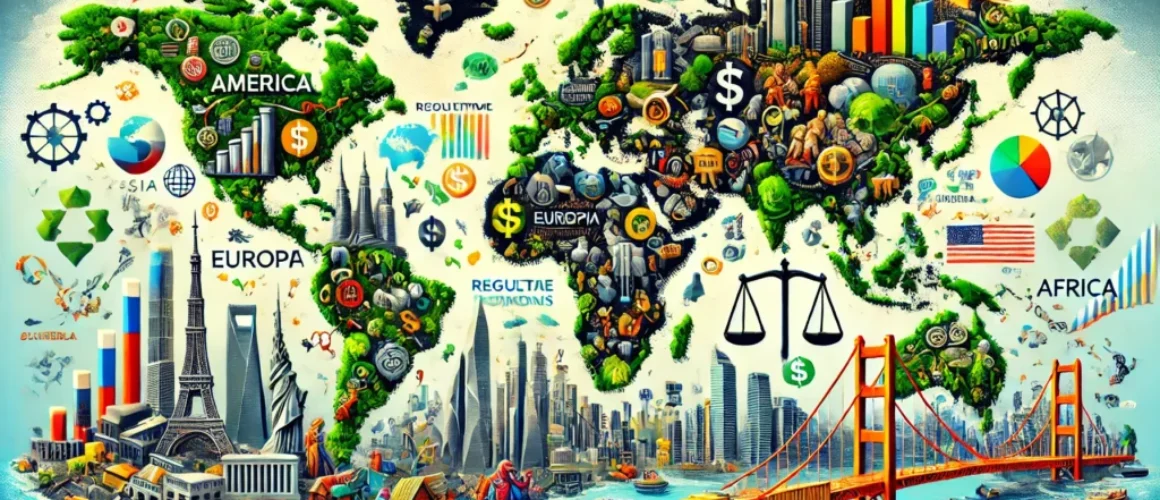A Worldview in Transition: The Diverging Paths of America, Europe, Russia, Asia, and Africa
The modern world is marked by starkly contrasting approaches to development, governance, and economic strategy across major regions. These divergences are not just academic observations—they actively shape global trade, innovation, and the balance of power. Today, we see America investing heavily, Europe focusing on regulation, and Russia struggling to bridge the gap due to systemic corruption. Meanwhile, Asia emerges as a powerhouse of low-cost production, disconnected from Europe by Russia’s inability to serve as a stable gateway. In this complex picture, Africa stands out as the heart of global growth, offering a vision of hope and peace through its burgeoning population and potential.
America: The Investor’s Playground
The United States, with its robust economy, continues to prioritize innovation and investment. From Silicon Valley’s tech giants to its thriving startup ecosystem, America has positioned itself as the global leader in future-forward industries like artificial intelligence, renewable energy, and biotechnology. Its investment-driven economy thrives on a culture of risk-taking and entrepreneurship, supported by venture capital and government incentives for research and development.
However, America’s model is not without challenges. The pursuit of profit often leads to income inequality and occasional market excesses. Yet, its ability to attract talent and capital from around the world ensures its continued leadership on the global stage.
Europe: A Regulated Fortress
Europe, in contrast, has adopted a heavily regulatory approach. The European Union (EU) emphasizes sustainability, consumer protection, and data privacy. Initiatives like the Green Deal aim to make Europe the first climate-neutral continent, while regulations such as the General Data Protection Regulation (GDPR) set global standards for data management.
While these measures reflect a commendable commitment to ethical governance and long-term stability, they can also stifle innovation. European companies often struggle to compete with their American and Asian counterparts, burdened by compliance costs and slower decision-making processes. Nonetheless, Europe’s regulatory framework sets an example of accountability and fairness, even if it occasionally hampers agility.
Russia: Corruption as a Roadblock
Russia, geographically and historically positioned as a gateway between Europe and Asia, has failed to leverage this strategic advantage. Corruption permeates its political and economic systems, undermining trust and deterring investment. Infrastructure projects stall or fail outright, with funds siphoned off by powerful elites.
As a result, Russia has become a bottleneck rather than a bridge. European nations are wary of relying on Russia for energy and trade routes, opting instead to seek alternatives. For Asia, the cost and risk of dealing with Russia outweigh any potential benefits, further isolating the country.
Asia: The Low-Cost Production Hub
Asia, particularly countries like China, India, and Vietnam, continues to dominate global production thanks to its low-cost labor and efficient supply chains. However, the lack of a reliable gateway to Europe limits these goods’ market reach. Russia’s inefficiency as a trade partner forces Asian producers to look elsewhere, strengthening ties with the Middle East, Africa, and even Latin America.
Despite these challenges, Asia’s capacity for mass production ensures it remains a critical player in the global economy. As infrastructure projects like the Belt and Road Initiative expand, Asia may bypass Russia entirely, reshaping global trade routes.
Africa: The Heart of Global Growth
Amidst these shifting dynamics, Africa emerges as a beacon of peace and growth. With the fastest-growing population in the world, the continent holds immense potential for the future. Its youthful demographic is a vital resource, capable of driving innovation, entrepreneurship, and cultural enrichment. Africa’s agricultural resources, combined with efforts to improve infrastructure and education, position it as a rising force in the global economy.
While Africa faces challenges such as political instability and limited industrialization, its focus on community and sustainability makes it a symbol of hope in an increasingly divided world. The continent’s emphasis on collective growth and harmony stands in stark contrast to the cutthroat competition seen elsewhere, reminding the world of the power of unity and collaboration.
The Missing Gate and a New World Order
Russia’s role as a potential bridge between Asia and Europe is squandered by corruption and mismanagement. Instead of facilitating trade and cultural exchange, it serves as a barrier. This vacuum creates opportunities for other regions, including Africa, to step into a more prominent global role.
The world’s economic landscape is increasingly defined by these divergent paths. America’s investments fuel innovation, Europe’s regulations champion sustainability, Asia’s production powers global supply chains, and Africa’s population growth embodies the promise of a brighter future. In this era of transformation, collaboration and adaptability will determine who thrives and who lags behind.

